Hi Xavier, thanks for taking the time to talk about Carnegie. You’re the very first guest in this interview series on the origin stories of board games and I couldn’t be happier starting it with you.
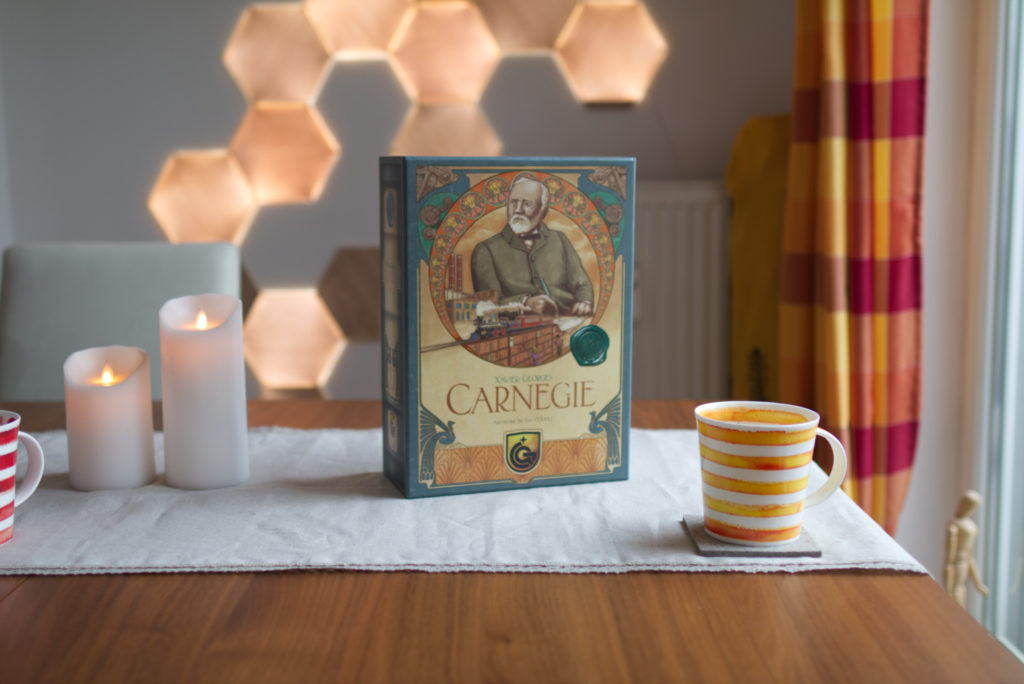
From Initial Idea to Design
Most people probably know you as one of the co-designers of Troyes and Black Angle or from your solo-designs of Ginkgopolis and Carson City. You’re one of those designers that only comes out with a new game every couple of years, but when you do, people notice. What initially got you started working on what we today know as Carnegie?
Xavier: Initially, I wanted to make a game about the Gilded Age in the United States. The game was originally urban and was called Mayor of Chicago. That was back in 2013. Then it evolved into a map featuring all of the United States and was called “Wells Fargo” for a long time. Carnegie didn’t arrive until late 2016. So the theme of economic development in the United States is indeed the basis of the game. But I was not very happy to limit the horizon of the game to the accumulation of wealth. I discovered Carnegie somewhat by accident while looking for new sources of inspiration to improve the game. Carnegie came along at the end of 2016, and his vision of wealth accumulation and philanthropy helped me to come up with the game as it is today.
You are working as an Architectural Engineer and designing games is just a passion of yours. So I imagine you have to carefully consider on what game ideas you actually spend your time developing them. How long did Carnegie take to develop?
Xavier: Between the day I started working on this theme and the release of the game, nine years have passed. Of course there are times when the work progresses, and other times when the game remains on hold. I work on average 1 to 3 days a week on my game projects. And always on several projects in parallel. When I’m out of inspiration on one prototype, I work on another. Some projects will remain on the shelf forever.
At what point in the process did you realise that Carnegie could be a full game and not just another idea that ends up in a folder somewhere?
Xavier: I have a little trouble answering this question because I don’t keep a journal of my creations. In general, I am very critical of my own creations. I first test my ideas on my own, and only share them when the game is good. And finally, I only present them to an editor when I get good feedback. And again, I received good feedback on Carnegie several times, but it wasn’t enough to convince me because I still wasn’t getting what I was looking for. One of the ideas that made me think “yes, I’m onto something good” was when I realised that one player’s choice of action could trigger the income of other players.
Carnegie is one of your solo designs but you had very successful collaborations in the past as well. What makes you decide to join up with others versus working on your own and does it change how long it will take to develop a game?
Xavier: There are no rules in this matter.
What part of Carnegie took you the longest to get just right?
Xavier: The balancing of the different departments was the most complicated. In particular, the balance between the departments that request to send an employee on a mission and the others. Indeed, if it is more interesting to keep your workers in the company, no more employees are sent on missions, and the game does not work. On the other hand, if you don’t need to keep your employees in your company, the game is too easy.
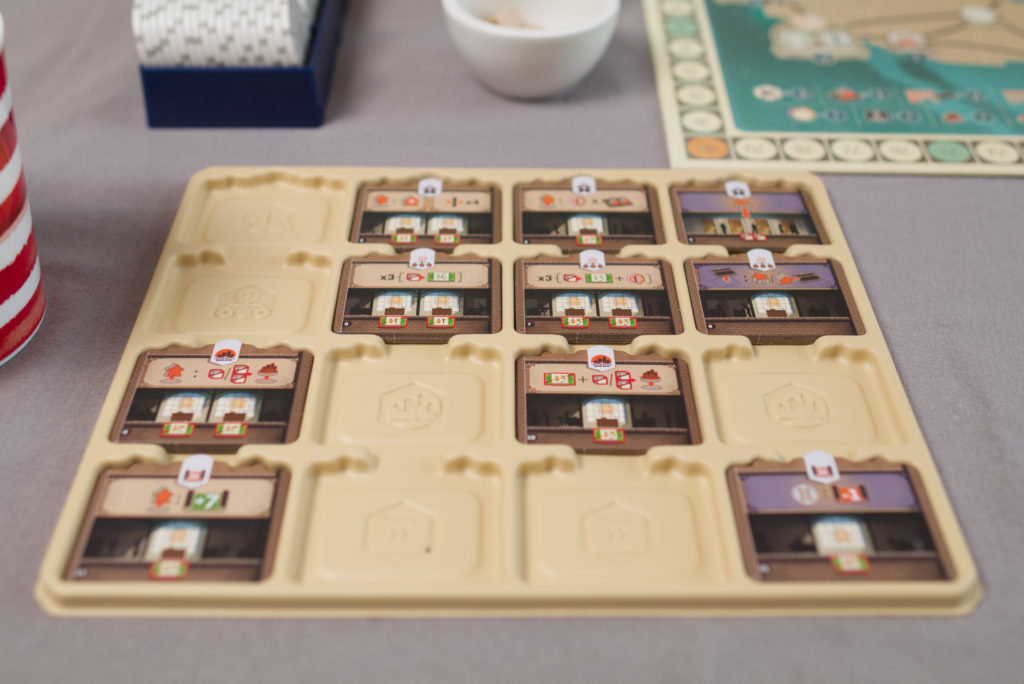
Do you have any “golden rules” that you try to apply to all new games you design?
Xavier: There are no golden rules, only a few recurring intentions: limit downtime, encourage interaction, multiply the paths to victory, abandon useless or overly complex rules.
As a middle-European, I had never really heard much about Andrew Carnegie before your game. How much did you know about him when you started and what did your research on him look like?
Xavier: Wikipedia.
How important is it for you to have a theme/setting during the design process?
Xavier: I love working on a game with a theme, that’s my favourite thing. The theme helps me a lot to imagine game mechanics. However, sometimes it’s the other way around, the starting point is a mechanic and then I ask myself the question: what theme fits perfectly with this game mechanic?
Refining Gameplay
There are a lot of small details in Carnegie that feel like very deliberate design choices. The main game loop for example seems to be carefully crafted. Why did you add the rule that workers lie down and have to be activated by paying money instead of just having to move them?
Xavier: This cost represents the cost and time to train and equip a new workstation. Mechanically, this cost balances the strength of each department.
The timeline is also crafted in an interesting way. What was your rational of fixing the end regions for each action when the rest of the timeline is randomised?
Xavier: It is important that each region is at the end of the timeline. If everything is randomised, a region could end up as doomed long before the end of the game, with abandoned employees that are impossible to recover.
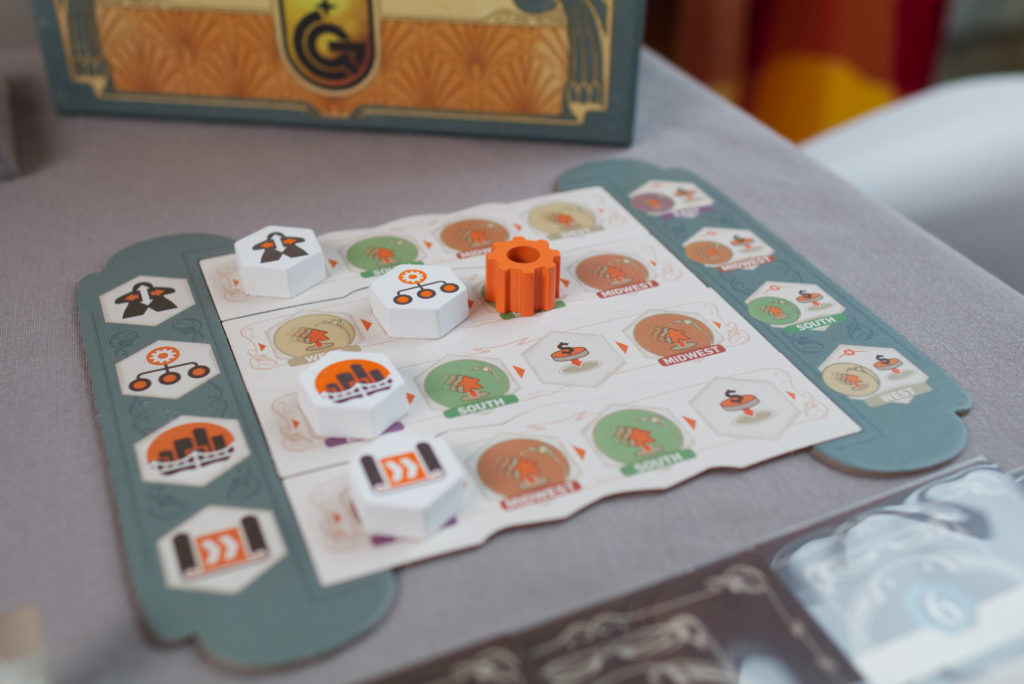
Something I have always wondered about is how one designs a good map. How did you approach the map for Carnegie and what were your design considerations?
Xavier: I was inspired by a historical map, but then I had to adapt it for the interest of the game. For example, the number of building sites is not at all proportional to the importance and demographic weight of the cities of the time. With proportional representation, the east of the map should be much more important compared to the rest.
Adding the connection bonus points seems like a cruel carrot that you are dangling in front of the players faces. The game is teasing players to try to connect all major cities, but it is easy to overspent ones effort. What was your intent when you balanced it against the other sources of victory points? How important is it to get a large connection bonus?
Xavier: The intention is to create tension and interaction on this aspect of the game, to bring interaction between players. On the one hand, I didn’t want to make it too difficult and frustrating. So I wanted to make it difficult to block other players. This is the case because the number of available disks is limited. On the other hand, it is perfectly possible to play and win without worrying about connections. And if you don’t care about connections, it’s also easier to block others because you can use your disks for that.
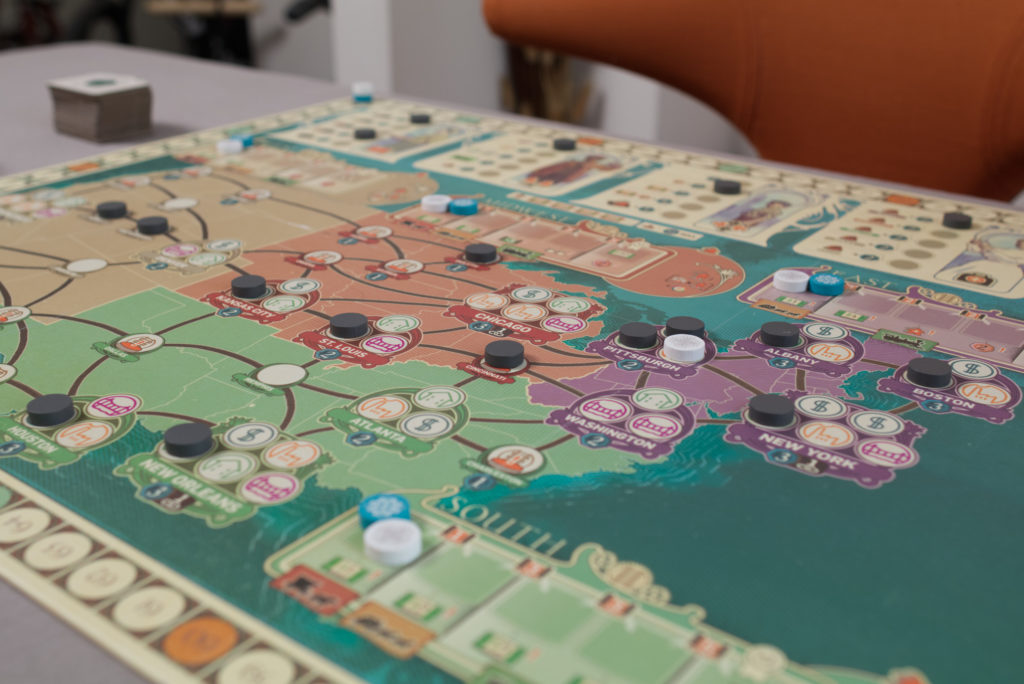
To connect San Francisco, there are four main routes: the long north route, the straight paths through empty small cities, the Los Angeles – Denver route and the south route towards Houston. I’ve seen players rush up on the south transportation track and then use the south route very successfully, I’ve seen players going Los Angeles – Denver to not waste anything, and I’ve seen players using the straight path through the barren small cities to save time. What’s the idea behind the north route and have you seen someone use it to actually connect San Fransisco – Denver?
Xavier: This road is there because it reflects an aspect of the historical map I used to design the game. It can pay off with certain combinations of donations, but it is rarely used because it is both very long and easy to block.
There are a number of small thematic details hidden in the map. For example, the rather barren region in the west, the fact that the east is the only place where one can get new workers as a transportation track bonus, and so on. Did you start from a thematic integration and then later make them work or did you want to add mechanical asymmetry and then had to make it fit thematically?
Xavier: This is an ongoing process in the development of the game. Whenever there is a choice to be made, I try to incorporate a thematic touch.
A number of players think that a heavy investment in R&D is essential to winning Carnegie. Would you agree or is that just what intuitively feels right to euro gamers?
Xavier: The last game I played, I largely won with only the starting R&D department. Of course, I didn’t [go for] public infrastructure and I reached the train level in each region without advancing further.
There seems to be a progression from beginner to advanced players. Beginners seem to think one has to do X or always needs to do Y, where advanced players see way more different, viable options. How many valid major strategies like heavy build rush, quick transportation track improvement, heavy department building do you think are there in Carnegie?
Xavier:
- to quickly build the public infrastructure buildings
- recruit the 5 additional employees as soon as possible
- score as many points as possible thanks to the study points (end of the tabs), even if not everything is built
- progress quickly on the transport development tracks and send as many employees as possible on mission
- build a maximum of departments
- base a strategy on a very small number of well-chosen departments (which score points)
And of course :
- link the 4 major cities (preventing if possible the other players from doing so)
- don’t forget to make donations that fit with the chosen strategy
HR and R&D are both actions where players initially have no way of sending employees on missions. Was that a deliberate choice and how did you choose which department tiles allowed sending employees and which do not?
Xavier: Yes, it is a deliberate choice. This is both a matter of theme (difficult to build without sending employees to the construction site) and mechanism (only the two departments that are 2 squares away from the entrance hall can send employees on missions).
In many ways, Carnegie is limiting players: one cannot build more projects than one has researched, there is only a limited amount of projects one can research, etc. Why did you add the flexibility to – in a pinch – exchange goods for money?
Xavier: In an economic development game like Carnegie, your earnings grow exponentially. You run out of everything at the beginning, in the middle everything is fine and at the end you are flush with money. The increasing cost of donations keeps things in balance and keeps the money tight. But there was nothing for the goods. The consequence is that players often end up with a lot of useless goods at the end of the game. With this rule, a player can use his surplus goods, even if it remains unattractive.
The solo automa is remarkably well done. It captures the essence of the game with a minimum amount of admin work and there are ways to adjust the difficulty. Do you play games solo yourself?
Xavier: Je ne joue jamais en solo, seulement pour mes propres jeux. [translated: I never play solo, only for my own games.]
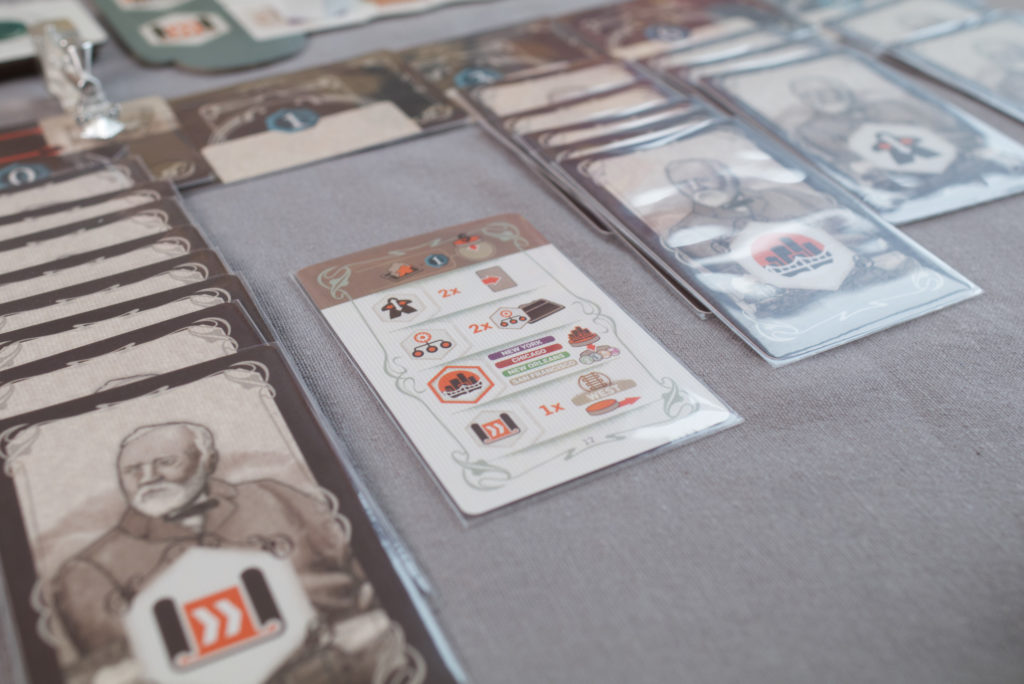
Development
At some point you started talking with Quined Games. In what state was the game when you handed it over to the publisher?
Xavier: The first time I presented the game to Quined, the theme of the game was set, and the rules were 80% complete. Obviously, not the public version of the rules, but a working version.
Some publishers are very hands off while others do a lot of editing, even so far as completely changing the theme. What was it like working with Quinted Games?
Xavier: Quined Games is a publisher very attentive to the wishes of the author and does not change anything without his agreement. One of the few things Quined wanted to change was the title of the game. The name I had chosen was “About Andrew”, but that name didn’t really fit a pure management game.
Ian O’Toole is one of the most popular board game artists right now, so it must have been an investment to work with him instead of less known and thus cheaper artist. Why did you and Quined Games decide to do it?
Xavier: Basically, I love Ian’s work, and I had just worked with him on Black Angel, to our great satisfaction. I was the one who [suggested] to work with Ian on Carnegie and I was very happy that Quined accepted.
How was your collaboration with Ian? Was he working on the completed rule set and then came back with the fully illustrated result or did some of his feedback change the gameplay?
Xavier: Ian has been incredible in his work on the layout of the rules and the iconography. He made suggestions to make it easier to understand.
Kickstarter
Carnegie had a successful Kickstarter early in 2021 with over 6000 backers, fulfilled mid 2022 and by the time of writing is also available in retail. What was it like as the author to follow the Kickstarter?
Xavier: I was not on the front line during the KS campaign (fortunately for me). I tried to take into account the comments of the players that are relevant, as many of them are. Especially on the way the game rules are presented and explained. However, it is never possible to please everyone.
What’s the process of coming up with stretch goals like? I imagine it’s difficult to create a cohesive, complete design and then add stuff.
Xavier: Initially, I only wanted a complete box with one funding level to reach. But the demand from the players (and the publisher) was too strong and they finally chose to offer stretch goals. Luckily I already had a few expansions that were almost ready.
In contrast to many other kickstarters, Carnegie didn’t do multiple pledge levels or added miniatures. Was that a deliberate choice?
Xavier: You are right, Quined and I only wanted supplements that made sense and were actually useful, not just there to justify the next goal.
Finished Product
What is your favourite small detail in the production or artwork?
Xavier: The four characters that illustrate the 4 types of donations. They are just soooo beautiful.
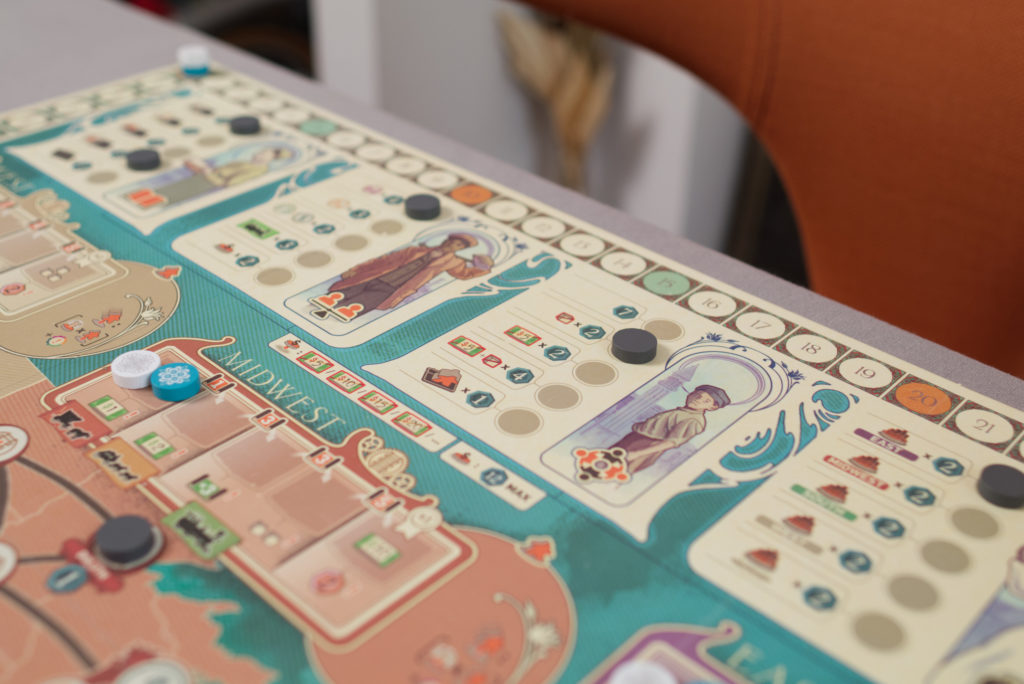
What’s your favourite initial department to pick? Personally I had great success with Advanced Research (13) and Supply Chain (7).
Xavier: My pleasure is to choose very different departments for each game and try to do the best I can with them. One of my favorites is #2 Recruiting. It’s a great one to start the game with, especially if the East region appears late on the timeline.
Do you think Carnegie is done or do you see room for expansions in the future?
Xavier: A strategy game of this type is never finished. There is always room to add variants and extensions. However, in my opinion, the game already offers a lot of possibilities. I’ve been considering another map, but it’s still far from being finished, and other projects are calling me.
And finally, what is a strategic tip you would give players that they might not have tried yet?
Xavier: Keep a balance in your business, so that any action remains useful to you. If an action is completely useless to you, it increases the risk that another player will choose it to annoy you.
(Disclaimer: The interview was done in writing with both being non-native English speakers. Corrections for clarity have been marked with square brackets. Many thanks to Xavier Georges for taking so much time out of his very busy schedule and giving all of us an in-depth look into Carnegie.)
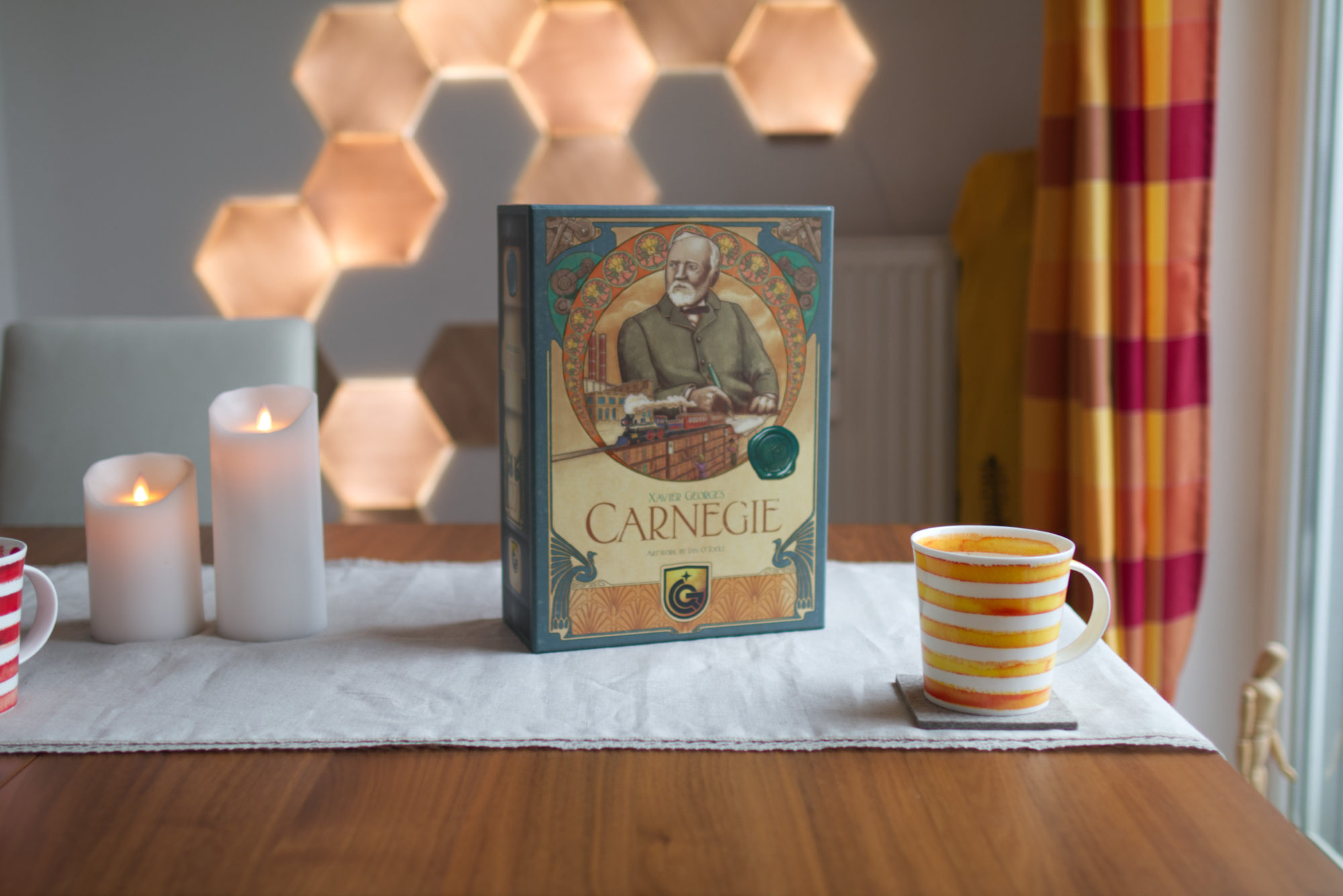
Very interesting article, thanks. Will be playing for the first time, and buying, Carnegie at Gridcon 4, next weekend. As a Scot I’d noticed the game previously but had too many other games on the shelf of shame to purchase it.
Carnegie is a great game, I still enjoy playing it very much. The first play is a bit rough because there are 16 departments one can buy and the very first thing players need to do is pick one as their starting department when they still have no feel for the game itself. But otherwise it’s just amazing how good this game is. I’ve also posted a review a while ago, might be interesting for you to read as well.